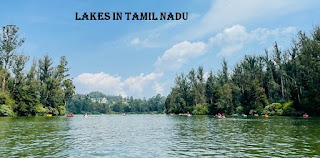Lakes in Tamil Nadu: Nature’s Reservoirs and Tourist Treasures
Tamil Nadu, the southernmost state of India, is a land of rich cultural heritage, architectural marvels, and natural beauty. While its temples, hill stations, and beaches often steal the spotlight, The Lakes of Tamil Nadu are equally captivating. These water bodies not only support the ecological balance and provide essential resources like drinking water and irrigation, but also serve as serene retreats for tourists and locals alike. From ancient man-made reservoirs to scenic high-altitude lakes, Tamil Nadu Lakes are as diverse as they are vital.
Ambattur Lake: Chennai’s Lifeline
Located
in the bustling city of Chennai, Ambattur Lake is a
crucial rain-fed reservoir. It plays a significant role in supplying drinking
water to the city’s residents. Along with Korattur Aeri and Madhavaram Aeri, it
forms a chain of interconnected water bodies that help manage excess rainfall
by transferring water from one lake to another. This system is not only
practical but also a testament to the ingenuity of urban water management in
Tamil Nadu.
Chembarambakkam Lake: A Reservoir Under Threat
Situated
in Kanchipuram district, Chembarambakkam Lake is another major reservoir that
quenches the thirst of Chennai. However, over the years, it has faced
challenges due to sedimentation, which has reduced its water-holding capacity.
Despite this, the lake remains a vital source of water and a reminder of the
need for sustainable lake management practices.
Ooty Lake: A Scenic Highland Escape
Nestled
in the Nilgiri Hills, Ooty Lake is a man-made marvel spread across 65 acres.
Surrounded by eucalyptus groves and misty hills, the lake is a popular tourist
destination. Boating on its calm waters offers a tranquil experience, making it
a must-visit spot in the hill station of Ooty. The lake also hosts an annual
boat race and summer festival, adding to its charm.
Veeranam Lake: A Chola Legacy
Veeranam
Lake, located near Lalpet in Cuddalore district, is steeped in history. Built
in the 10th century by Rajaditya Chola, this reservoir spans a catchment area
of 25 square kilometers. It continues to serve as a crucial water source for
irrigation and drinking purposes. The lake is a living example of the Chola
dynasty’s advanced engineering and commitment to water conservation.
Kaliveli Lake: A Wetland of Global Importance
Kaliveli
Lake in Viluppuram district is one of India’s largest seasonal wetlands.
Recognized by the International Union for Conservation of Nature (IUCN) as a
wetland of both national and international importance, Kaliveli is a
biodiversity hotspot. It supports a wide variety of migratory birds and aquatic
species, making it a paradise for birdwatchers and ecologists. The lake’s
seasonal nature adds to its ecological complexity and significance.
Singanallur Lake: An Urban Oasis in Coimbatore
Located
in the heart of Coimbatore, Singanallur Lake covers an area of 1.153 square
kilometers. With an average depth of 4.25 meters and a water volume of over 52
million cubic meters, it is one of the city’s largest lakes. However, the lake
is known for its high alkalinity levels, which pose challenges for aquatic
life. Despite this, it remains a popular spot for fishing, birdwatching, and
leisure activities.
These
lakes not only support agriculture and water supply but also contribute to the
ecological health of their regions. Many of them are being restored and
maintained through community participation and government initiatives.
Ecological and Tourism Significance
Lakes in
Tamil Nadu are more than just water bodies—they are ecosystems that support
flora, fauna, and human life. They act as natural flood control systems,
recharge groundwater, and provide habitats for countless species. From a
tourism perspective, lakes like Ooty, Kodaikanal, and Emerald are major
attractions, drawing visitors with their scenic beauty and recreational
opportunities.
Moreover,
the cultural and historical significance of lakes like Veeranam adds another layer
of richness to Tamil Nadu’s heritage. Festivals, rituals, and local folklore
often revolve around these lakes, making them integral to the social fabric of
the state.
Conclusion
Tamil
Nadu’s lakes are a blend of natural splendour, historical legacy, and
ecological importance. Whether nestled in the hills or spread across the
plains, these lakes are vital to the state’s environment and economy. As
tourism grows and urbanization expands, it becomes increasingly important to
preserve and protect these water bodies. With thoughtful conservation and Sustainable Tourism the lakes of Tamil Nadu can continue to thrive
as jewels of the southern landscape.




Comments
Post a Comment